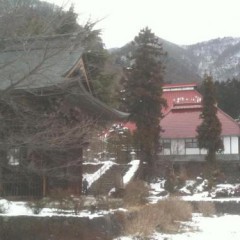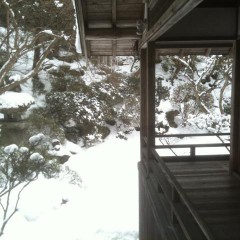小布施に行った時に、せっかくだったから岩松院に行ってみました。北斎の鳳凰の絵や、一茶の俳句で知られていますから、楽しみにしていました。
北斎の絵は本当に畳に寝って見るのか?
一茶はどういう所からカエル合戦を見たのか?
色々と興味津々でした。
そして、見事に受付が方は熱心だし、ものすごく詳しかったのでとっても良かった。私が聞きたかった質問をしっかり答えてくれた上で、なお詳しい事を色々と教えてくれました。
一番驚いたのは、北斎の絵はずっと見えているけど、色は薄くならないのかと心配していましたが、北斎は絵を塗った時に、色の変更現象を計算していて、書いてから200年先で一番鮮やかになる様に作ったと、受付の方が教えてくれました。
という事は、完成してから160年がたっていますので、これから40年後にこの絵が一番良いそうです。40年後という事は私が80歳… その時に又来なっきゃ!
While at Obuse the other day, I also went to see Ganshoin Temple. It is famous for a ceiling painting by ukiyo-e master Hokusai as well as being the setting for one of Issa's most well-known haiku poems.
I had heard and read so much about the temple, so I was looking forward to seeing it in person. Do you really lie down on the tatami to look at Hokusai's painting? From where did Issa watch the frog mating that inspired his poem?
I had so many questions!
And luckily, the lady behind the counter was full of answers. Not only did she cure my curiosity, but she shared a number of fascinating facets about the temple.
The thing that amazed me the most was regarding the pigments in Hokusai's painting of a pheonix on the ceiling. I inquired if the colors were fading at all after being on display constantly for so many years. The lady told me Hokusai picked the pigments, he calculated their natural evolution over time in such a way that the painting's colors would be at their most brilliant 200 years after he finished. It's been on display for 160 years, so that means in another 40 years from now, the painting will be at its peak coloration.
I'm 40 now, so that means I have to come back to see it again when I'm 80 years old!
There are so many stories in that one painting -- hidden Mt. Fuji's, depictions of age-old leaves and branches that had grown attached to the 'ancient' phoenix, the gruesome fact as to why no spiders ever make webs on the painting (some of the pigments were made from poisons), etc. etc.
And then there was the garden, and the pond that was the home to the frog mating ritual that inspired Issa to write his famous poem:
"Yase-gaeru,
Makeru na! Issa,
Kore ni ari."
Roughly translated, it means
"Skinny Frog,
Don't give up! Issa
Is here."
He apparently had taken pity on a smaller frog that was getting muscled out of the way competing with larger frogs for mating. The poem is said to have been dedicated to Issa's son who was battling an illness. Unfortunately, the son died not long after Issa wrote the haiku.
I took a quiet moment taking in the scene of the wood decked balcony overlooking the pond, home to the frolics of the battle frogs as well as to a poignant story of human drama from long, long ago.





